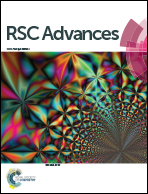Acid promoted cyclodehydration of amino alcohols with amide acetal†
Abstract
A convenient acid-promoted cyclization protocol for the formation of azaheterocycles from amino alcohols is described. The reaction involves the use of N,N-dimethylacetamide dimethyl acetal (DMADA) as the activating reagent of the hydroxyl group. Using this protocol, pyrrolidines or piperidines with various substituents can be synthesized in good to high yields.


 Please wait while we load your content...
Please wait while we load your content...